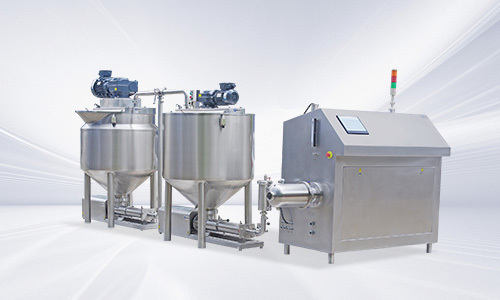Streamlining Your Yogurt Production Line for Maximum Efficiency

2025/11/06
Streamlining Your Yogurt Production Line for Maximum Efficiency
Table of Contents
- Introduction to Yogurt Production
- The Importance of Efficiency in Yogurt Production
- Key Components of a Yogurt Production Line
- Steps to Streamline Your Production Process
- Technological Advancements in Yogurt Manufacturing
- Ensuring Quality Control in Yogurt Production
- Training Your Workforce for Maximum Efficiency
- Case Studies and Success Stories
- Future Trends in Yogurt Production
- Conclusion
- FAQs About Yogurt Production Efficiency
Introduction to Yogurt Production
Yogurt has been a beloved staple in diets around the world for centuries. Its creamy texture and tangy flavor make it a popular choice for breakfast, snacks, and even desserts. As the demand for yogurt continues to rise, manufacturers face the challenge of producing high-quality products while maintaining efficiency.
To meet consumer expectations and remain competitive, it is crucial for yogurt producers to streamline their production lines. This article delves into the essential components of yogurt manufacturing and offers actionable strategies to enhance efficiency.
The Importance of Efficiency in Yogurt Production
Efficiency in yogurt production not only impacts output but also has a direct effect on profitability. Streamlined operations lead to reduced operational costs, minimized waste, and improved product quality. By focusing on efficiency, manufacturers can achieve:
- **Increased Production Rates:** Maximizing output while maintaining quality.
- **Lower Operational Costs:** Reducing waste and labor costs through optimization.
- **Enhanced Product Quality:** Achieving consistent quality that meets consumer standards.
- **Improved Sustainability:** Implementing eco-friendly practices that resonate with consumers.
Key Components of a Yogurt Production Line
To streamline a yogurt production line effectively, it is essential to understand its key components:
1. Milk Processing Equipment
This includes homogenizers and pasteurizers, which ensure the milk is safe for consumption and has a uniform texture. Proper maintenance and calibration of these machines are crucial for efficiency.
2. Fermentation Tanks
Fermentation tanks are where the magic happens. The milk is inoculated with live cultures, and maintaining optimal temperature and conditions in these tanks is critical for successful fermentation.
3. Filling and Packaging Systems
Automated filling and packaging lines can significantly speed up production. Utilizing advanced technology in this area can reduce human error and ensure hygienic practices.
4. Quality Control Stations
Incorporating quality control checkpoints throughout the production process ensures that any defects are identified and rectified before reaching the consumer.
Steps to Streamline Your Production Process
Optimizing your yogurt production line involves several strategic steps:
1. Conduct a Thorough Assessment
Evaluate your current production processes to identify bottlenecks and inefficiencies. Utilize data analytics tools to gain insights into production metrics and trends.
2. Implement Lean Manufacturing Principles
Adopt lean manufacturing techniques to eliminate waste and enhance productivity. This includes minimizing excess inventory, reducing waiting times, and streamlining workflows.
3. Upgrade Technology
Investing in state-of-the-art equipment can drastically improve efficiency. Look for technologies that offer automation, real-time monitoring, and data analytics capabilities.
4. Standardize Procedures
Create standard operating procedures (SOPs) for each stage of the production process. This ensures consistency and quality while reducing training time for new employees.
5. Foster a Culture of Continuous Improvement
Encourage employees to suggest improvements and innovations. Regular team meetings to discuss challenges can lead to valuable insights and solutions.
Technological Advancements in Yogurt Manufacturing
The yogurt production industry benefits immensely from technological innovations. Some notable advancements include:
1. Smart Sensors and IoT
Integrating smart sensors into production lines enables real-time monitoring of various parameters, such as temperature and pH levels. This facilitates better control over fermentation and product consistency.
2. Automated Systems
Automation in filling, labeling, and packaging processes can streamline operations and reduce labor costs. Automated systems ensure accuracy and efficiency, particularly in high-volume production.
3. Data Analytics
Utilizing data analytics can help manufacturers predict trends, optimize inventory levels, and improve production planning. By harnessing big data, yogurt producers can make informed decisions that enhance efficiency.
Ensuring Quality Control in Yogurt Production
Quality control is paramount in yogurt production. Maintaining high standards not only ensures consumer satisfaction but also cultivates brand loyalty.
1. Establish Quality Control Protocols
Develop comprehensive quality control protocols that cover all aspects of production, from raw material sourcing to final product testing.
2. Regular Testing and Calibration
Conduct regular testing of raw ingredients and finished products to ensure compliance with health and safety regulations. Additionally, calibrate equipment frequently to maintain accuracy.
3. Customer Feedback Loop
Create mechanisms for receiving customer feedback on product quality. This data can be invaluable in identifying areas for improvement and ensuring consumer preferences are met.
Training Your Workforce for Maximum Efficiency
A skilled workforce is crucial for optimizing yogurt production. Training programs should focus on:
1. Equipment Operation
Ensure that employees are well-trained in the operation of all machinery. In-depth knowledge of equipment can prevent mishaps and ensure smooth operations.
2. Quality Assurance Practices
Train staff in quality assurance protocols to foster a culture of accountability and excellence in product quality.
3. Continuous Learning and Development
Encourage ongoing training and professional development to keep employees updated on industry trends, safety practices, and technological advancements.
Case Studies and Success Stories
Examining successful yogurt production companies can provide valuable insights. For instance, a leading yogurt manufacturer implemented an automated filling system, resulting in a 30% increase in production efficiency. Their commitment to continuous improvement and technology adoption serves as a model for others in the industry.
Future Trends in Yogurt Production
As the yogurt industry evolves, several trends are emerging:
1. Plant-Based Yogurt Alternatives
With growing consumer demand for plant-based products, yogurt manufacturers are exploring non-dairy yogurt alternatives. This trend necessitates a reevaluation of production processes to integrate new ingredients effectively.
2. Sustainability Practices
Sustainable production methods are becoming increasingly important. Manufacturers are adopting eco-friendly packaging and sourcing local ingredients to reduce their carbon footprint.
3. Personalized Nutrition
As consumers seek personalized health solutions, yogurt producers may explore customizable products that cater to specific dietary needs and preferences.
Conclusion
Streamlining your yogurt production line is essential for maximizing efficiency, improving profitability, and meeting consumer demands. By focusing on key components, adopting cutting-edge technologies, and fostering a culture of continuous improvement, yogurt manufacturers can enhance their operations and deliver high-quality products. Embracing these strategies will not only position your business for success in the competitive yogurt market but also pave the way for sustainable growth.
FAQs About Yogurt Production Efficiency
1. What are the key benefits of streamlining yogurt production?
Streamlining yogurt production leads to increased output, reduced operational costs, enhanced product quality, and improved sustainability.
2. How can technology improve yogurt production efficiency?
Technology, such as automation and data analytics, can optimize production processes, reduce labor costs, and ensure consistent product quality.
3. What training is necessary for employees in yogurt production?
Employees should be trained in equipment operation, quality assurance practices, and continuous learning to stay updated on industry trends.
4. How important is quality control in yogurt production?
Quality control is crucial for ensuring product safety and consistency, which ultimately affects consumer satisfaction and brand loyalty.
5. What future trends should yogurt producers be aware of?
Producers should consider trends like plant-based alternatives, sustainability practices, and personalized nutrition to stay competitive and meet consumer demands.
Yogurt production line
Previous Page











